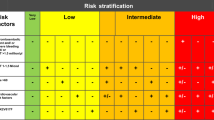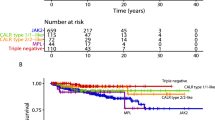Abstract
From 1981 to 1995, we diagnosed, followed and treated at our institution fifty-eight cases of essential thrombocythemia (ET), using hydroxyurea (HU) as first-line therapy in these patients. Three patients who were continuously receiving HU had a leukemic transformation after a chronic phase of respectively 47, 81 and 90 months. One patient developed an acute leukemia with minimal myeloid differentiation (AML MO) and soon died of refractory disease; the second developed a refractory anemia with excess blasts in transformation (t-RAEB) and survived one year; the third patient developed a chronic myelomonocytic leukemia (CMML) and is alive at 21 months. The two former patients had complex nonrandom bone marrow karyotypic abnormalities, suggestive of therapy-related leukemia, whereas the latter one had a normal karyotype throughout the chronic and leukemic phase. These findings, together with recently published results on myeloproliferative disorders (MPD) treated with HU, suggest that this drug might be as leukemogenic as other myelosuppressive therapies in patients with ET. Long-term HU therapy should be reserved for patients in whom the treatment benefits obviously outweigh the risk of inducing leukemia.
Similar content being viewed by others
Explore related subjects
Discover the latest articles and news from researchers in related subjects, suggested using machine learning.Author information
Authors and Affiliations
Rights and permissions
About this article
Cite this article
Liozon, E., Brigaudeau, C., Trimoreau, F. et al. Is treatment with hydroxyurea leukemogenic in patients with essential thrombocythemia? An analysis of three new cases of leukaemic transformation and review of the literature. Hematol Cell Ther 39, 11–18 (1997). https://doi.org/10.1007/s00282-997-0011-x
Received:
Accepted:
Issue Date:
DOI: https://doi.org/10.1007/s00282-997-0011-x




